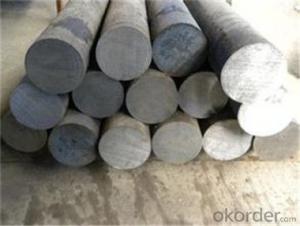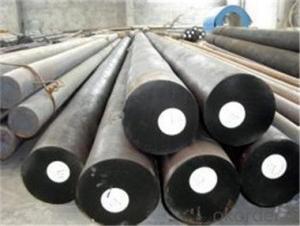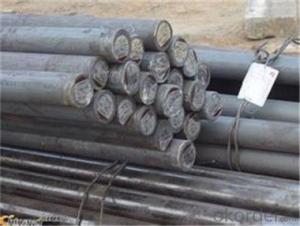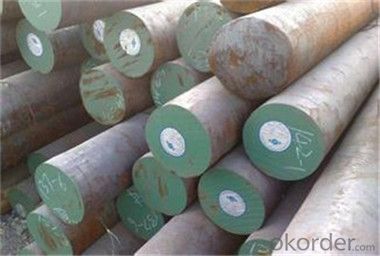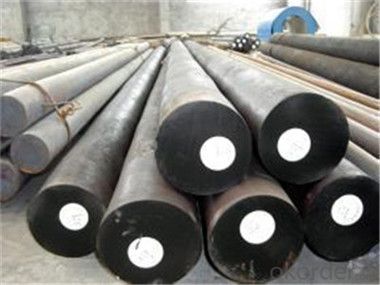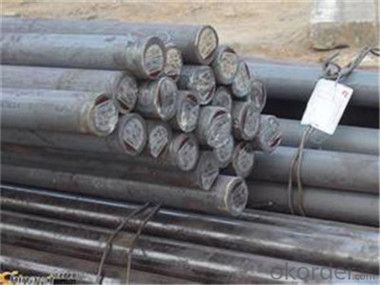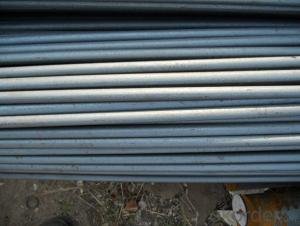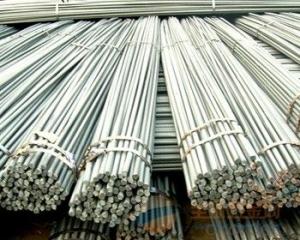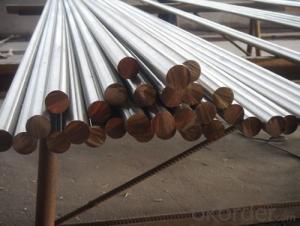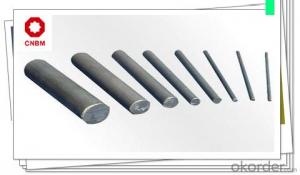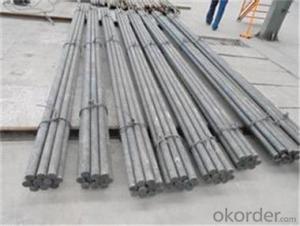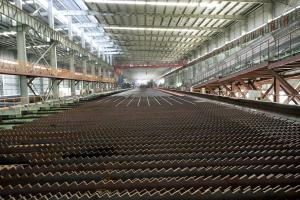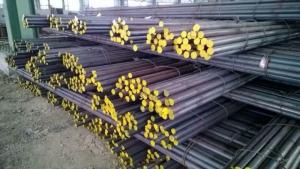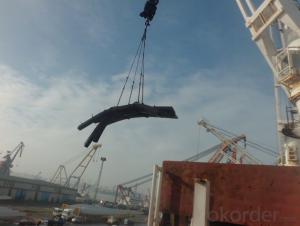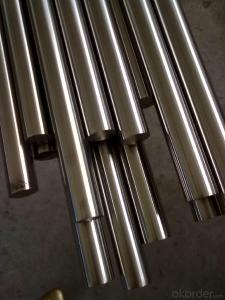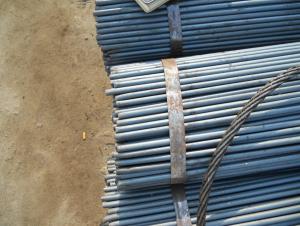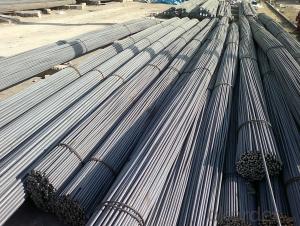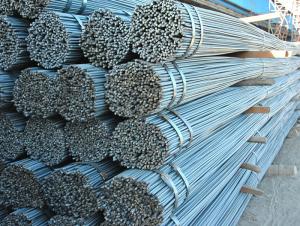Hot Rolled Carbon Steel Round Bar MS Bar
- Loading Port:
- Tianjin
- Payment Terms:
- TT OR LC
- Min Order Qty:
- 40 m.t.
- Supply Capability:
- 2000000 m.t./month
OKorder Service Pledge
OKorder Financial Service
You Might Also Like
Description of steel round bar:
1. Commodity: Round steel bar
3. Technical: Hot rolling
2. Length: Min. 5.8meter, according to requirement.
3. Diameter: 16mm-250mm
5. Packing: In Bundle or according to your requirements.
Festures of steel round bar:
Description : Steel Bar/Stainless Steel Round Bar/Alloy Steel Round Bar/Carbon Steel Bar
Stainless Steel Bright Bar/Stainless Steel Peeled Bar/Stainless Steel Polishing Bar
Diamater:
1 Hot rolled round bar diameter from 5.5mm to 110mm
2.Hot forged round bar diameter from 110mm to 400mm
3.Cold drawn round bar diameter from 2.0mm to 60mm
4.Grinding bar diameter from 4.0mm to 40mm
5.Turn smooth diameter from 40mm to 250mm
Specifications of steel round bar:
Length: standard 6m,9m,12m, or as customers' requirement
Surface: Black, polished, grinded, ,Bright, Turn smooth(Peeled),Brush,Mill,Pickled
Process:Hot rolled,cold drawn,forged
Packing: In bundle, tied by steel straps, covered with protecting film Use wooden box, fill with foam to keep the surface from damaging
Images of steel round bar:
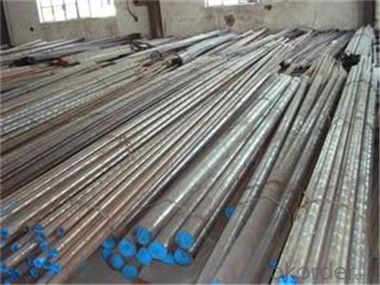
FAQ:
1. What is your main market?
We mainly export to Asia such as Japan,Korea,Thailand and North America and Middle East.
2. How long is the lead time?
Delivery time: 45 days after order confirmed.
3. What payment term do you accept?
Payment: T/T or L/C at sight.
4.Why do you choose to cooperate with us?
We have over10 years experience in this business so we are able to provide you the high quality products with the best price.
- Q: Can steel round bars be used for making gears or sprockets?
- Yes, steel round bars can be used for making gears or sprockets. Steel is a commonly used material in gear and sprocket manufacturing due to its high strength, durability, and resistance to wear and tear. Steel round bars can be machined or forged into the desired shape and then cut, drilled, or milled to create the necessary teeth or grooves required for gear or sprocket functionality. The specific type of steel and its heat treatment can be chosen based on the application requirements, such as load capacity, speed, and environmental conditions. Overall, steel round bars are a versatile and reliable choice for manufacturing gears and sprockets.
- Q: Can steel round bars be coated for added protection?
- Steel round bars can indeed be coated to provide additional protection. Coating these bars is effective in boosting their resistance to corrosion, wear and tear, as well as other environmental factors that may cause deterioration or damage. There are multiple coating options available for steel round bars, including hot-dip galvanizing, epoxy coating, powder coating, and zinc plating. These coatings create a protective layer that acts as a barrier between the steel and its surroundings, thus preventing direct contact with corrosive substances or abrasive elements. By coating steel round bars, not only does their lifespan and durability increase, but their aesthetic appearance also improves. The choice of coating depends on the specific application, environment, and desired level of protection.
- Q: How do steel round bars differ from other types of steel bars?
- Steel round bars possess different characteristics compared to other types of steel bars, primarily in their shape and versatility. Unlike square or flat bars, steel round bars have a cylindrical shape and a circular cross-section, which grants them greater adaptability and flexibility. One of the main benefits of steel round bars lies in their capability to endure high levels of stress and pressure. Their circular shape ensures a uniform distribution of weight and pressure, making them ideal for applications that demand durability and strength. Consequently, these bars find wide usage in construction, manufacturing, and engineering projects that prioritize structural integrity. Another noteworthy distinction is the ease of machining and manipulation that steel round bars provide. Their cylindrical shape facilitates effortless drilling, cutting, and shaping, rendering them highly versatile and suitable for a vast range of applications. They can be conveniently welded, bent, or formed into diverse shapes, granting them an edge over other steel bar variations in terms of customization. In terms of appearance, steel round bars possess a distinctive visual allure. The sleek and cylindrical surface of these bars grants them a polished and refined appearance, making them aesthetically pleasing in architectural and decorative applications. In conclusion, steel round bars stand apart from other steel bar types due to their shape, versatility, and strength. Their ability to endure high levels of stress, ease of machining, and appealing aesthetics make them a favored choice in numerous industries.
- Q: What is the difference between hot rolled and cold drawn steel round bars?
- Hot rolled steel round bars are produced by heating a steel billet or ingot at a high temperature and then rolling it into the desired shape. This process results in a rougher surface finish and a larger diameter tolerance compared to cold drawn steel round bars. Hot rolled bars are commonly used in applications where strength and durability are important, such as in construction and manufacturing. On the other hand, cold drawn steel round bars are produced by pulling a hot rolled bar through a die at room temperature, which results in a smoother surface finish and tighter diameter tolerances. This process also improves the mechanical properties of the steel, such as its strength and hardness. Cold drawn bars are often used in applications where precision and a high-quality surface finish are required, such as in the production of shafts, bolts, and precision components. In summary, the main differences between hot rolled and cold drawn steel round bars are the surface finish, diameter tolerance, and mechanical properties. Hot rolled bars have a rougher surface finish, larger diameter tolerances, and are typically used in applications where strength and durability are important. Cold drawn bars have a smoother surface finish, tighter diameter tolerances, and are commonly used in applications where precision and a high-quality surface finish are required.
- Q: How do you store and handle steel round bars?
- Steel round bars should be stored in a dry and covered area to protect them from moisture and corrosion. They should be stacked horizontally on a flat surface, with spacers in between each layer to prevent deformation. When handling steel round bars, it is important to wear appropriate protective gear such as gloves and safety shoes. They should be lifted using proper lifting equipment, ensuring that the load is evenly distributed. Additionally, bars should not be dragged or rolled on the ground to avoid scratches or damage.
- Q: Can steel round bars be used for making gears?
- Yes, steel round bars can be used for making gears. Steel round bars are commonly used in gear manufacturing due to their high strength, durability, and excellent machinability. They can be easily formed and shaped into the desired gear design, making them an ideal choice for various applications requiring reliable and robust gear systems.
- Q: What are the advantages of using creep-resistant steel round bars?
- Using creep-resistant steel round bars in various applications has several advantages. Firstly, these bars offer exceptional resistance to high temperatures and prolonged stress exposure, making them ideal for high temperature environments such as power plants, boilers, and engines. Their ability to maintain their mechanical properties at elevated temperatures is a key advantage. Secondly, these round bars possess superior creep strength, allowing them to endure constant stress over extended periods without deformation or failure. This is particularly crucial in applications where components are subjected to continuous stress, such as pressure vessels or structural machinery. The high creep strength ensures the longevity and reliability of these components. Additionally, creep-resistant steel round bars exhibit excellent corrosion resistance. They are often alloyed with elements like chromium, molybdenum, or nickel, enhancing their ability to resist corrosion in harsh environments. This makes them suitable for industries like oil and gas, chemical processing, and marine applications where corrosion is a significant concern. Furthermore, these round bars possess favorable weldability, facilitating easy fabrication and assembly. They can be welded to other components without compromising their mechanical properties, making them versatile and cost-effective for construction projects. Moreover, these round bars offer dimensional stability and high hardness, guaranteeing that components maintain their shape and mechanical properties even under extreme conditions. This characteristic makes them suitable for applications requiring precision and accuracy, such as aerospace and automotive industries. In conclusion, the advantages of using creep-resistant steel round bars include their ability to withstand high temperatures, superior creep strength, corrosion resistance, weldability, dimensional stability, and high hardness. These advantages make them the preferred choice for various industries where reliability, longevity, and performance under harsh conditions are essential considerations.
- Q: Can steel round bars be used in the production of shafts?
- Yes, steel round bars can be used in the production of shafts. Steel round bars are often used as a raw material in the manufacturing process of shafts due to their strength, durability, and versatility. They can be machined or forged into the desired shape and size required for the shaft, and their inherent properties make them suitable for various applications such as automotive, machinery, and construction industries. Steel round bars offer excellent mechanical properties, including high tensile strength, good impact resistance, and resistance to corrosion, making them an ideal choice for shafts that require high load-bearing capacity and reliability. Additionally, steel round bars can be heat-treated to further enhance their strength and hardness, ensuring optimal performance and longevity of the shafts in various operating conditions.
- Q: What is the difference between a seamless and a welded steel round bar?
- The main difference between a seamless and a welded steel round bar lies in their manufacturing processes. A seamless steel round bar is produced by piercing a solid cylindrical billet, while a welded steel round bar is created by welding together multiple pieces of steel. This results in a seamless bar having a smoother surface and uniform composition, making it stronger and more resistant to corrosion. On the other hand, a welded round bar may have visible seams due to the welding process, which can affect its strength and durability.
- Q: Can steel round bars be used for making valves or fittings?
- Yes, steel round bars can be used for making valves or fittings. Steel round bars offer excellent strength, durability, and corrosion resistance, making them suitable for various applications in the manufacturing of valves and fittings. They can be easily machined, welded, and fabricated to meet specific design requirements, ensuring reliable and long-lasting performance in valve and fitting systems.
Send your message to us
Hot Rolled Carbon Steel Round Bar MS Bar
- Loading Port:
- Tianjin
- Payment Terms:
- TT OR LC
- Min Order Qty:
- 40 m.t.
- Supply Capability:
- 2000000 m.t./month
OKorder Service Pledge
OKorder Financial Service
Similar products
Hot products
Hot Searches
Related keywords

